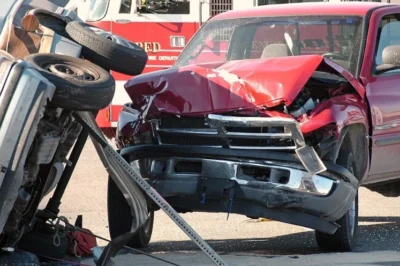The Importance of Accident Reconstruction in Complex Personal Injury Cases

Personal injury cases can be difficult to navigate, especially when the circumstances surrounding an accident are unclear. When multiple parties are involved or when the details of the incident are disputed, proving liability can be challenging. This is where accident reconstruction becomes a critical part of building a case. In Florida, where car accidents and other personal injury claims are common, accident reconstruction plays a vital role in determining the facts and supporting a victim’s claim.
What is Accident Reconstruction?
Accident reconstruction is a detailed process that aims to recreate the events leading up to, during, and after an accident. Experts use scientific methods, data analysis, and sometimes advanced technology to determine how an accident occurred, what factors contributed to it, and how specific events unfolded. This process is especially important in complex personal injury cases where the details of the incident are unclear, or where there are conflicting accounts from witnesses or involved parties.
In the context of personal injury law, accident reconstruction can provide vital evidence that helps clarify liability. For example, in a car accident, reconstruction experts can determine the speed of the vehicles at the time of impact, whether any traffic laws were violated, and how the crash happened. This data can be essential in establishing fault, which is a key component in personal injury lawsuits.
How Accident Reconstruction Benefits Complex Cases
Accident reconstruction is not just a tool for clarifying simple incidents. It becomes particularly important when dealing with complex personal injury cases, such as those involving multiple vehicles, severe injuries, or unclear liability. Here’s how accident reconstruction can be a game-changer in these situations:
- Clarifying Liability in Disputed Cases
In many personal injury cases, particularly those involving multiple parties, it can be difficult to determine who is at fault. If each party has a different version of events, the case may quickly become a matter of he-said-she-said. Accident reconstruction allows experts to sift through the available evidence, such as vehicle damage, skid marks, and crash site data, to reconstruct the sequence of events. By applying principles of physics and engineering, they can often show exactly how the accident unfolded, leaving little room for ambiguity.
- Providing a Clear Picture for Insurance Companies and the Court
Insurance companies and courts rely on factual evidence when determining the outcome of a personal injury case. When an accident reconstruction expert can provide concrete, scientifically-backed data, it can be more persuasive than mere witness testimony. In complex cases, where eyewitness accounts may vary or be unreliable, accident reconstruction can provide a more accurate and trustworthy depiction of what actually occurred.
- Supporting Expert Testimony
In many personal injury cases, expert witnesses are called to testify. Accident reconstruction experts are no exception. Their testimony can carry significant weight in court. They use data collected from the accident site, such as the point of impact, damage to vehicles, and witness statements, to form an opinion on how the accident happened. This testimony is critical in proving liability and establishing causation between the defendant’s actions and the plaintiff’s injuries.
- Determining the Severity of Injuries
In some cases, the severity of the injuries sustained in an accident can be difficult to prove, especially in instances where the injuries are not immediately apparent. Accident reconstruction can help by providing insight into the forces involved during the crash. For example, if a car was hit at a high speed, the force of the impact could explain more severe injuries, even if there are no visible signs of trauma. This information can strengthen a personal injury case by showing a direct link between the collision and the injuries sustained.
Common Tools and Techniques Used in Accident Reconstruction
Accident reconstruction is a complex process that often requires the use of various tools and techniques to gather data and analyze the accident. Some of the most common methods include:
-
Crash Data Retrieval (CDR): Modern vehicles are often equipped with event data recorders (EDRs), also known as black boxes, that capture data such as speed, braking, and impact forces. Accident reconstruction experts can retrieve this data to help recreate the events leading up to the crash.
-
Physical Evidence Analysis: Experts examine the scene of the accident for physical evidence like skid marks, debris, and vehicle damage. This can help determine factors such as speed, the direction of travel, and how the vehicles were positioned before and after the crash.
-
Computer Simulation: Advanced computer programs can be used to create simulations of the accident based on available data. These simulations can provide a detailed, visual representation of how the accident occurred, which can be especially useful in court.
-
Witness Testimony and Photographs: Accident reconstructionists may also rely on photographs of the scene, witness statements, and video footage to piece together the timeline of events.
When is Accident Reconstruction Necessary?
Not every personal injury case requires an accident reconstruction. However, it becomes essential in situations where the details of the accident are unclear or when there are serious disputes about fault. Accident reconstruction is typically needed in cases involving:
-
Multiple vehicles: When several vehicles are involved, determining fault can be more complicated. Accident reconstruction can help clarify which driver caused the accident and how.
-
Severe injuries or fatalities: In cases involving serious injuries or fatalities, it is crucial to understand the exact cause of the accident and how it led to the victim’s injuries.
-
Contested liability: When the parties involved in the accident offer conflicting versions of events, accident reconstruction can provide objective evidence to support one side’s claims.
Conclusion
Accident reconstruction is an invaluable tool in complex personal injury cases, especially in Florida, where car accidents are all too common. By providing an accurate, detailed account of the events leading up to an accident, reconstruction experts can help clarify liability, support claims of damages, and ultimately ensure that justice is served. Whether the case involves a single vehicle or a multi-vehicle crash, accident reconstruction offers a way to sift through the confusion and focus on the facts, making it a key element in securing a favorable outcome for the injured party.

 Call Us Today - It's Free
Call Us Today - It's Free